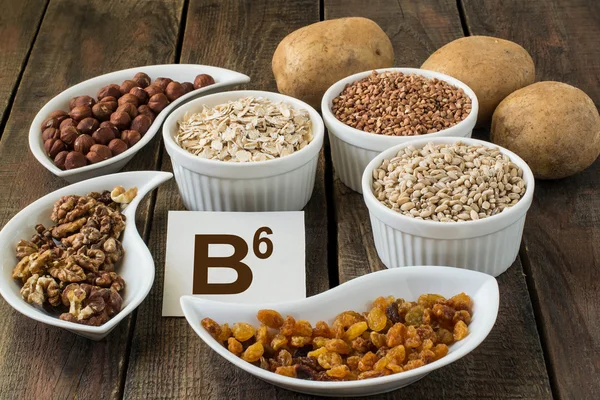- Vitamin B6, known as Pyridoxine, is a water-soluble vitamin that belongs to the B-complex family.
- From boosting energy levels to supporting brain function and immune health, this vitamin is a true multitasker.
Functions of Vitamin B6
- Energy Metabolism: Vitamin B6 is like the spark plug for your body’s energy production. It breaks down carbohydrates and converts into usable energy.
- So, if you’re looking to stay active and alert, B6 is your friend.
- Brain Health: Vit. B6 is essential for brain development and function and plays a role in mood regulation, memory, and cognitive processes.
- Skin Health: It participates in the production of collagen, a protein vital for maintaining healthy skin, and supports repair of skin cells.
- Immunity Support: Vitamin B6 assists in the production of antibodies that help fight off infections and diseases.
- A well-functioning immune system is your body’s defense mechanism, and B6 helps keep it in top shape.
- Hemoglobin Production: Vitamin B6 aids in hemoglobin production, ensuring your body receives the oxygen it needs to function properly.
- Nervous System Health: It’s involved in the creation of myelin, a protective layer around nerve cells.
Daily Requirement of Vitamin B6
Recommended Dietary Allowance (RDA) of Vitamin B6 according to different age groups and genders:
Vitamin B6 Recommended Dietary Allowance (RDA)
| Age Group | Male (mcg/day) | Female (mcg/day) |
|---|---|---|
| Infants 0-6 months | 0.1 | 0.1 |
| Infants 7-12 months | 0.3 | 0.3 |
| Children 1-3 years | 0.5 | 0.5 |
| Children 4-8 years | 0.6 | 0.6 |
| Children 9-13 years | 1.0 | 1.0 |
| Adolescents 14-18 years | 1.3 | 1.2 |
| Adults 19-50 years | 1.3 | 1.3 |
| Adults 51 years and older | 1.7 | 1.5 |
| Pregnant Adults 19-50 years | 1.9 | |
| Lactating Adults 19-50 years | 2.0 | 2.0 |
[READ more…
Vitamin B6 Rich foods Sources
- Leafy Greens vegetables: Dark leafy greens like spinach contain vitamin B6. A 1-cup (cooked) serving of spinach provides about 0.4 mg of vitamin B6.
- Potatoes: A medium-sized potato (with skin) contains around 0.6-0.7 mg of vitamin B6.
- Bananas: One medium-sized banana provides about 0.4 mg of vitamin B6.
- Avocado: One medium-sized avocado contains approximately 0.5 mg of vitamin B6.
- Legumes: Chickpeas, lentils, and soybeans are rich in vitamin B6. A 1-cup (cooked) serving of chickpeas provides around 0.5 mg of vitamin B6.
- Nuts and Seeds: Pistachios, sunflower seeds, and sesame seeds are good sources of vitamin B6. A 1-ounce (28-gram) serving of pistachios contains about 0.2 mg of vitamin B6.
- Fish: Fish like salmon, tuna, and trout are rich in vitamin B6. A 3.5-ounce (100-gram) serving of cooked salmon contains about 0.5 mg of vitamin B6.
- Poultry: Chicken and turkey are good sources of vitamin B6. A 3.5-ounce (100-gram) serving of cooked chicken breast provides around 0.5-0.6 mg of vitamin B6.
Deficiency Disorder
If they don’t get enough vitamin B6 in their diet or have difficulty absorbing it, they can develop pyridoxine deficiency.
This deficiency can lead to a range of symptoms and health issues, including:
1. Neurological Symptoms:
- Tingling, numbness, and pain in extremities.
- Confusion and mood disturbances.
- Depression: Vitamin B6 is involved in the production of neurotransmitters like serotonin, which affect mood regulation.
- Seizures: In severe cases, deficiency can lead to epileptic seizures.
2. Skin Disorders:
- Dermatitis: Inflammation of the skin.
- Cheilosis: Cracking and inflammation of the lips.
- Glossitis: Inflammation of the tongue.
3 . Anaemia: Vitamin B6 is important for the production of hemoglobin, the protein in red blood cells that carries oxygen. Deficiency can lead to a type of anemia known as Sideroblastic anemia.
4. Deficiency can weaken the body’s ability to fight infections.
5. Memory issues and difficulty concentrating.
Treatment and Prevention:
The treatment of vitamin b6 for deficiency typically involves increasing dietary intake of vitamin B6-rich foods or taking vitamin B6 supplements, as advised by a healthcare professional.
commonly questions asked about vitamin B6 pyridoxine-related
Q.1. What is doxylamine pyridoxine?
Ans.- This is a combination medication often used to relieve nausea and vomiting during pregnancy. It consists of doxylamine (an antihistamine) and pyridoxine (Vitamin B6).
Q.2. What is the chemical formula of pyridoxine?
Ans.- Chemical Formula of Pyridoxine: C8H11NO3
Q.3. What is pyridoxine used for during pregnancy?
Ans.- to help alleviate symptoms of morning sickness and nausea.
Q.4. What is pyridoxine hydrochloride?
Ans.- Pyridoxine Hydrochloride: This is a form of Vitamin B6 that is commonly used in dietary supplements and medications.
Q.5. Does vitamin B6 help with nausea?
Ans.- Yes, Vitamin B6 can help with nausea, particularly during pregnancy, and help with the production of hemoglobin.
Q.6. Isoniazid effect on vitamin b6?
Ans.- Isoniazid, a medication used to treat tuberculosis, can lead to Vitamin B6 deficiency.
Q.7. How long to rid the body of vitamin B6 toxicity?
Ans.- It typically takes a few days to several weeks under medical supervision.
Q.8. Which food is the best source of vitamin B6?
Ans.- Bananas are an excellent source of Vitamin B6, but they can also be found in other foods like poultry, fish, potatoes, and fortified cereals.
Q.9. What does vitamin B6 do during pregnancy?
Ans.- It can help reduce morning sickness and nausea during pregnancy and help in red blood cell production.
Q.10. Why take vitamin B6 with melatonin?
Ans.- Some people take Vitamin B6 with melatonin as a supplement to potentially improve sleep quality.
